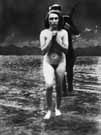
|
|
|

|

|

|

|
|
Click on an image to see a larger, more detailed picture.
|
|
|
|
|
| 1941: Mass Murder |

|
pg. 279 |

|
|
|
|
| |
 This violin once belonged to a Roma Gypsy, Miodrag Djordevic-Tukalia, from Yugoslavia. German soldiers shot him in the town of Kragujevac sometime between October 20 and 26, 1941, a week of mass shootings. Djordevic-Tukalia's son kept the violin as a memento of his deceased father.
This violin once belonged to a Roma Gypsy, Miodrag Djordevic-Tukalia, from Yugoslavia. German soldiers shot him in the town of Kragujevac sometime between October 20 and 26, 1941, a week of mass shootings. Djordevic-Tukalia's son kept the violin as a memento of his deceased father.
Photo: United States Holocaust Memorial Museum Photo Archive
|
 Naked and terrified, a young Jewish woman begs for her life. Already stripped of her clothes, she is pushed toward a mass grave, where she will be shot in the back of the head or machine-gunned. Because this photograph was snapped head-on and at eye level, it almost certainly was not taken surreptitiously. To the contrary, the photographer likely wished to make a document--or perhaps a keepsake--of this interlude in the day's work of his unit. One cannot help but wonder about this woman's fate: In their haste, the Einsatzkommandos sometimes failed to deliver a fatal shot, leaving a few of their victims to gasp for air and claw their way through the corpses surrounding them.
Naked and terrified, a young Jewish woman begs for her life. Already stripped of her clothes, she is pushed toward a mass grave, where she will be shot in the back of the head or machine-gunned. Because this photograph was snapped head-on and at eye level, it almost certainly was not taken surreptitiously. To the contrary, the photographer likely wished to make a document--or perhaps a keepsake--of this interlude in the day's work of his unit. One cannot help but wonder about this woman's fate: In their haste, the Einsatzkommandos sometimes failed to deliver a fatal shot, leaving a few of their victims to gasp for air and claw their way through the corpses surrounding them.
Photo: SYddeutscher Verlag Bilderdienst
|
 The Kovno Ghetto in Lithuania became one of the most infamous in Eastern Europe. This photograph shows the Ninth Fort, also known as Killing Center No. 2, where about 50,000 Jews were executed. After their deaths, the murderers pushed the victims into vast pits, which became mass graves containing as many as 3000 corpses.
The Kovno Ghetto in Lithuania became one of the most infamous in Eastern Europe. This photograph shows the Ninth Fort, also known as Killing Center No. 2, where about 50,000 Jews were executed. After their deaths, the murderers pushed the victims into vast pits, which became mass graves containing as many as 3000 corpses.
Photo: Zentrale Stelle der Landesjustizverwaltungen / United States Holocaust Memorial Museum Photo Archive
|
|

|

|

|

|
 October 30, 1941: A 12-year-old boy who escapes the Ninth Fort massacre of October 28 returns to the Kovno Ghetto and reveals what happened.
October 30, 1941: A 12-year-old boy who escapes the Ninth Fort massacre of October 28 returns to the Kovno Ghetto and reveals what happened.
|
 November 1941: More than 15,000 Serbian Jews deported to a concentration camp at Sajmiste, Yugoslavia, are later killed in mobile gassing units disguised as Red Cross vans.
November 1941: More than 15,000 Serbian Jews deported to a concentration camp at Sajmiste, Yugoslavia, are later killed in mobile gassing units disguised as Red Cross vans.
|
 November 1941: A Jewish ghetto is established at Brest-Litovsk, Belorussia.
November 1941: A Jewish ghetto is established at Brest-Litovsk, Belorussia.
|
 November 1941: Thousands of German-Jewish deportees arrive in Minsk, Belorussia.
November 1941: Thousands of German-Jewish deportees arrive in Minsk, Belorussia.
|
 November 1941: Newspapers in London and New York report Nazi murders of 52,000 Jews in Kiev, Ukraine.
November 1941: Newspapers in London and New York report Nazi murders of 52,000 Jews in Kiev, Ukraine.
|
 November 1, 1941: Construction of an extermination center begins at Belzec, Poland.
November 1, 1941: Construction of an extermination center begins at Belzec, Poland.
|
 November 1, 1941: A Jewish ghetto at Grodno, Belorussia, is established.
November 1, 1941: A Jewish ghetto at Grodno, Belorussia, is established.
|
 November 1, 1941: A Nazi-sanctioned concentration camp opens at Hadjerat-M'Guil, North Africa.
November 1, 1941: A Nazi-sanctioned concentration camp opens at Hadjerat-M'Guil, North Africa.
|
 November 5-6, 1941: Seventeen thousand Jews are killed outside Rovno, Ukraine.
November 5-6, 1941: Seventeen thousand Jews are killed outside Rovno, Ukraine.
|
|
|
|
|
| 1941: Mass Murder |

|
pg. 279 |

|
|
The Holocaust Chronicle
© 2009 Publications International, Ltd.
|
|
